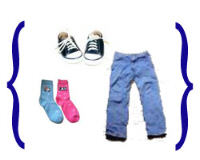- Statistics - a set of concepts, rules, and procedures that help us to:
- organize numerical information in the form of tables, graphs, and charts;
- understand statistical techniques underlying decisions that affect our lives and well-being; and
- make informed decisions.
- Data - facts, observations, and information that come from investigations.
- Measurement data sometimes called quantitative data -- the result of using some instrument to measure something (e.g., test score, weight);
- Categorical data also referred to as frequency or qualitative data. Things are grouped according to some common property(ies) and the number of members of the group are recorded (e.g., males/females, vehicle type).
- Variable - property of an object or event that can take on different values. For example, college major is a variable that takes on values like mathematics, computer science, English, psychology, etc.
- Discrete Variable - a variable with a limited number of values (e.g., gender (male/female), college class (freshman/sophomore/junior/senior).
- Continuous Variable - a variable that can take on many different values, in theory, any value between the lowest and highest points on the measurement scale.
- Independent Variable - a variable that is manipulated, measured, or selected by the researcher as an antecedent condition to an observed behavior. In a hypothesized cause-and-effect relationship, the independent variable is the cause and the dependent variable is the outcome or effect.
- Dependent Variable - a variable that is not under the experimenter's control -- the data. It is the variable that is observed and measured in response to the independent variable.
- Qualitative Variable - a variable based on categorical data.
- Quantitative Variable - a variable based on quantitative data.
- Graphs - visual display of data used to present frequency distributions so that the shape of the distribution can easily be seen.
- Bar graph - a form of graph that uses bars separated by an arbitrary amount of space to represent how often elements within a category occur. The higher the bar, the higher the frequency of occurrence. The underlying measurement scale is discrete (nominal or ordinal-scale data), not continuous.
- Histogram - a form of a bar graph used with interval or ratio-scaled data. Unlike the bar graph, bars in a histogram touch with the width of the bars defined by the upper and lower limits of the interval. The measurement scale is continuous, so the lower limit of any one interval is also the upper limit of the previous interval.
- Boxplot - a graphical representation of dispersions and extreme scores. Represented in this graphic are minimum, maximum, and quartile scores in the form of a box with "whiskers." The box includes the range of scores falling into the middle 50% of the distribution (Inter Quartile Range = 75th percentile - 25th percentile)and the whiskers are lines extended to the minimum and maximum scores in the distribution or to mathematically defined (+/-1.5*IQR) upper and lower fences.
- Scatterplot - a form of graph that presents information from a bivariate distribution. In a scatterplot, each subject in an experimental study is represented by a single point in two-dimensional space. The underlying scale of measurement for both variables is continuous (measurement data). This is one of the most useful techniques for gaining insight into the relationship between tw variables.
- Measures of Center - Plotting data in a frequency distribution shows the general shape of the distribution and gives a general sense of how the numbers are bunched. Several statistics can be used to represent the "center" of the distribution. These statistics are commonly referred to as measures of central tendency.
- Mode - The mode of a distribution is simply defined as the most frequent or common score in the distribution. The mode is the point or value of X that corresponds to the highest point on the distribution. If the highest frequency is shared by more than one value, the distribution is said to be multimodal. It is not uncommon to see distributions that are bimodal reflecting peaks in scoring at two different points in the distribution.
- Median - The median is the score that divides the distribution into halves; half of the scores are above the median and half are below it when the data are arranged in numerical order. The median is also referred to as the score at the 50thpercentile in the distribution. The median location of N numbers can be found by the formula (N + 1) / 2. When N is an odd number, the formula yields a integer that represents the value in a numerically ordered distribution corresponding to the median location. (For example, in the distribution of numbers (3 1 5 4 9 9 8) the median location is (7 + 1) / 2 = 4. When applied to the ordered distribution (1 3 4 5 8 9 9), the value 5 is the median, three scores are above 5 and three are below 5. If there were only 6 values (1 3 4 5 8 9), the median location is (6 + 1) / 2 = 3.5. In this case the median is half-way between the 3rd and 4th scores (4 and 5) or 4.5.
- Mean - The mean is the most common measure of central tendency and the one that can be mathematically manipulated. It is defined as the average of a distribution is equal to the SX / N. Simply, the mean is computed by summing all the scores in the distribution (SX) and dividing that sum by the total number of scores (N). The mean is the balance point in a distribution such that if you subtract each value in the distribution from the mean and sum all of these deviation scores, the result will be zero.


